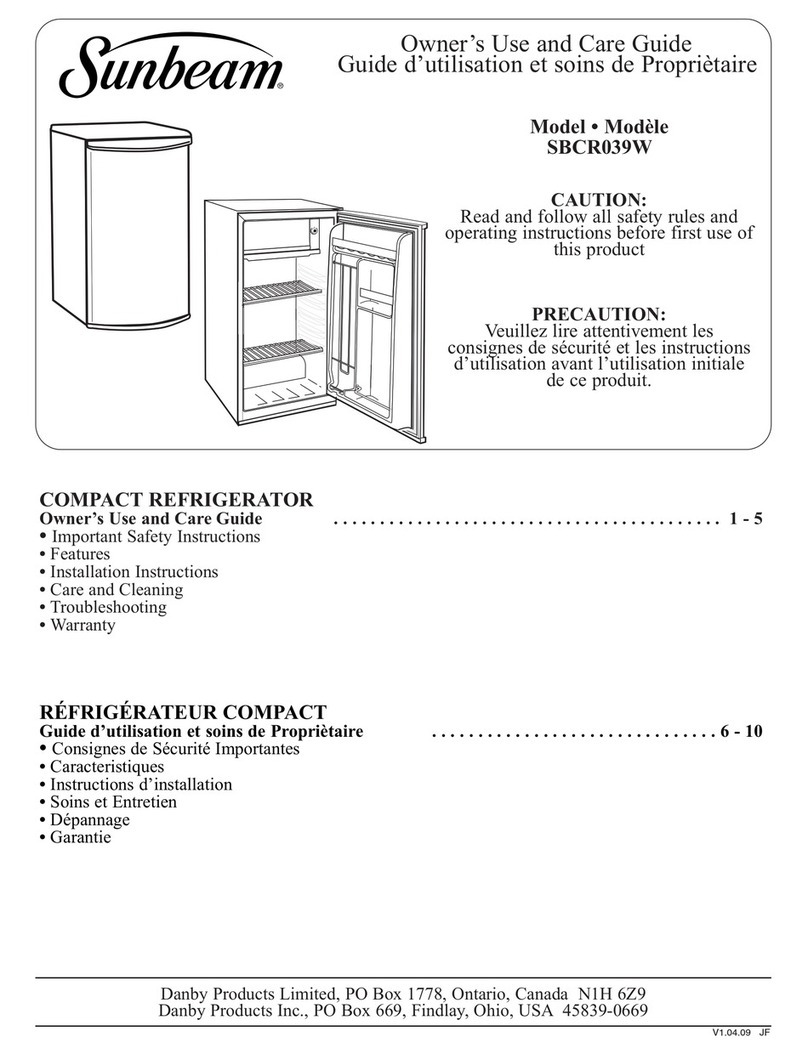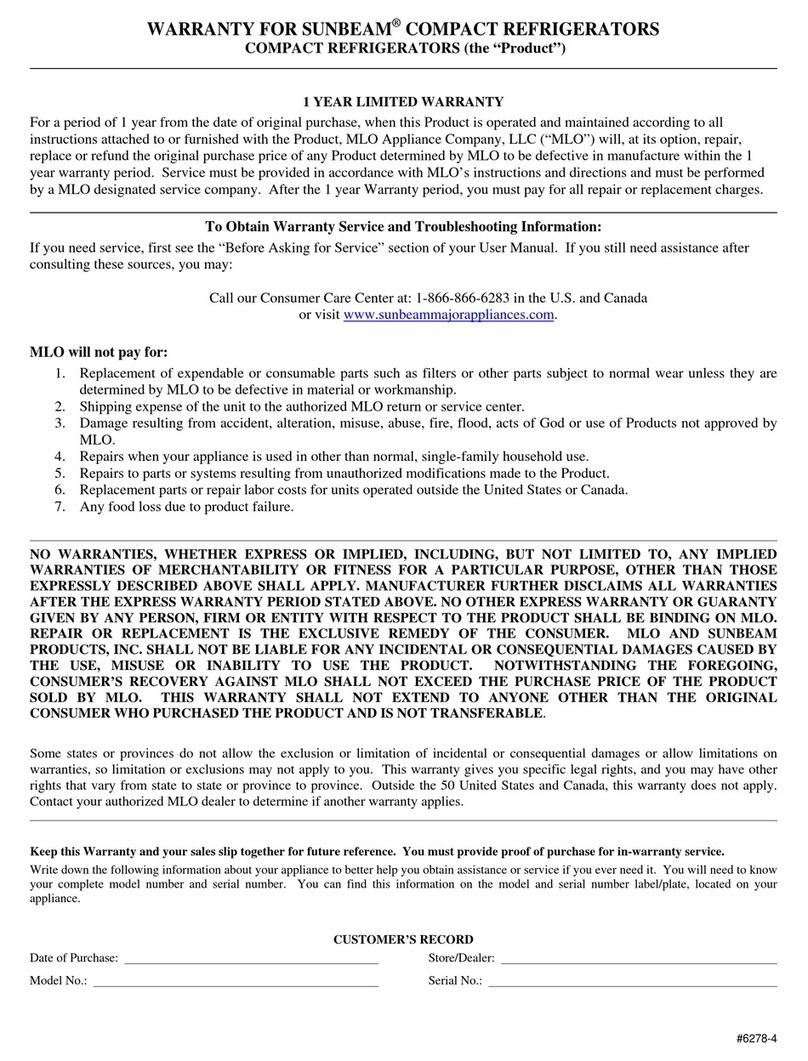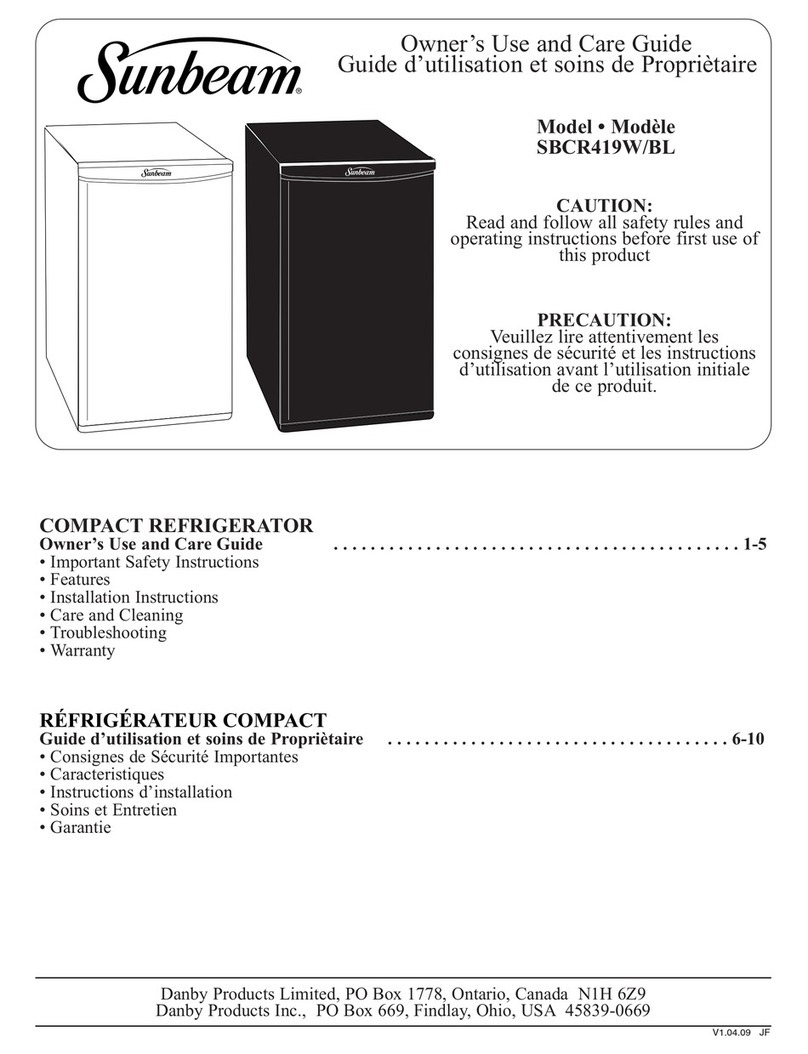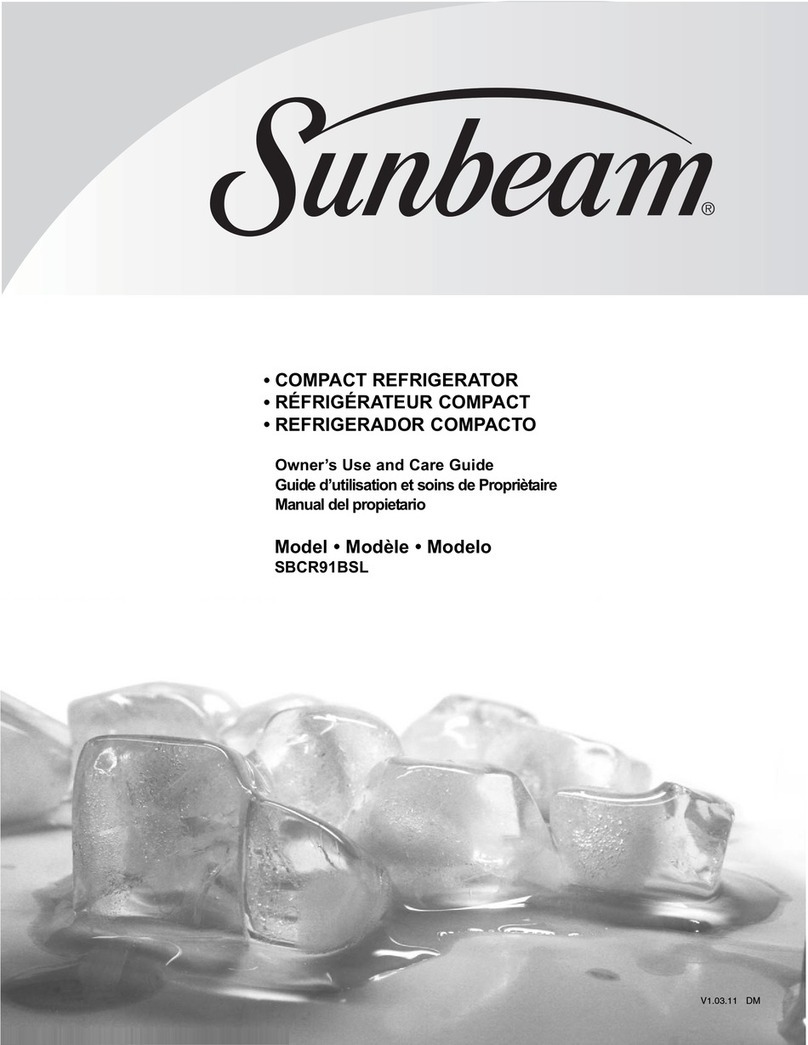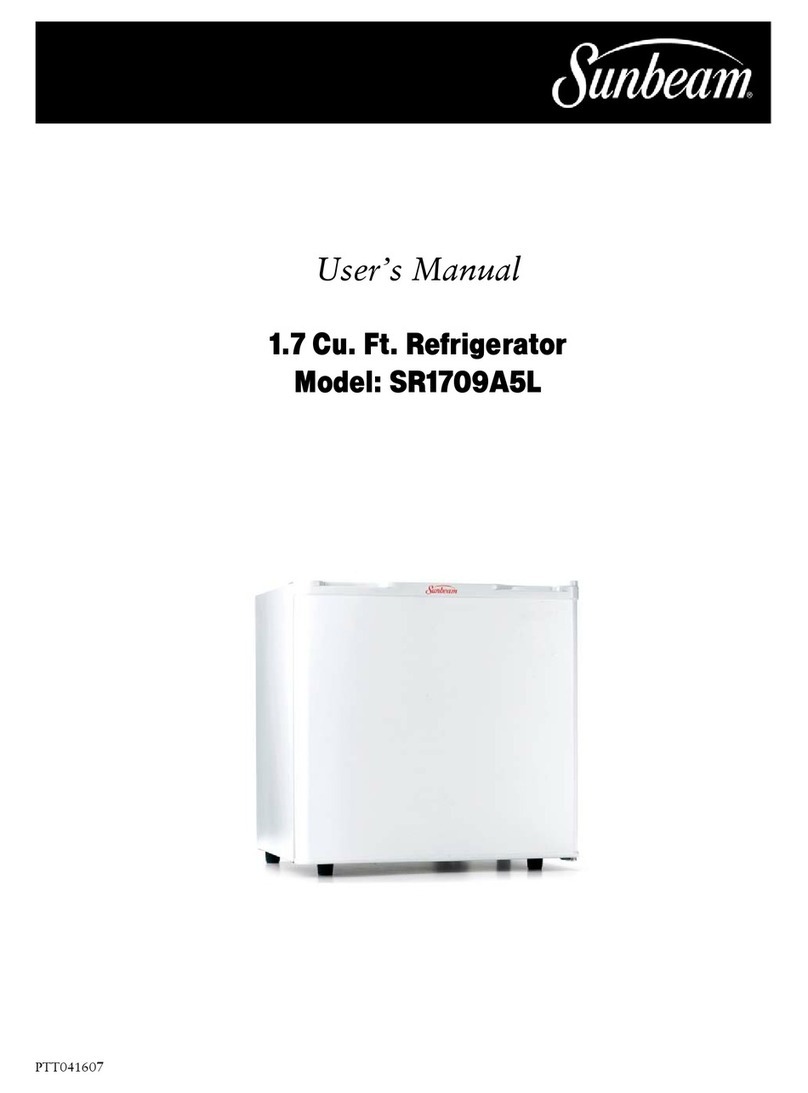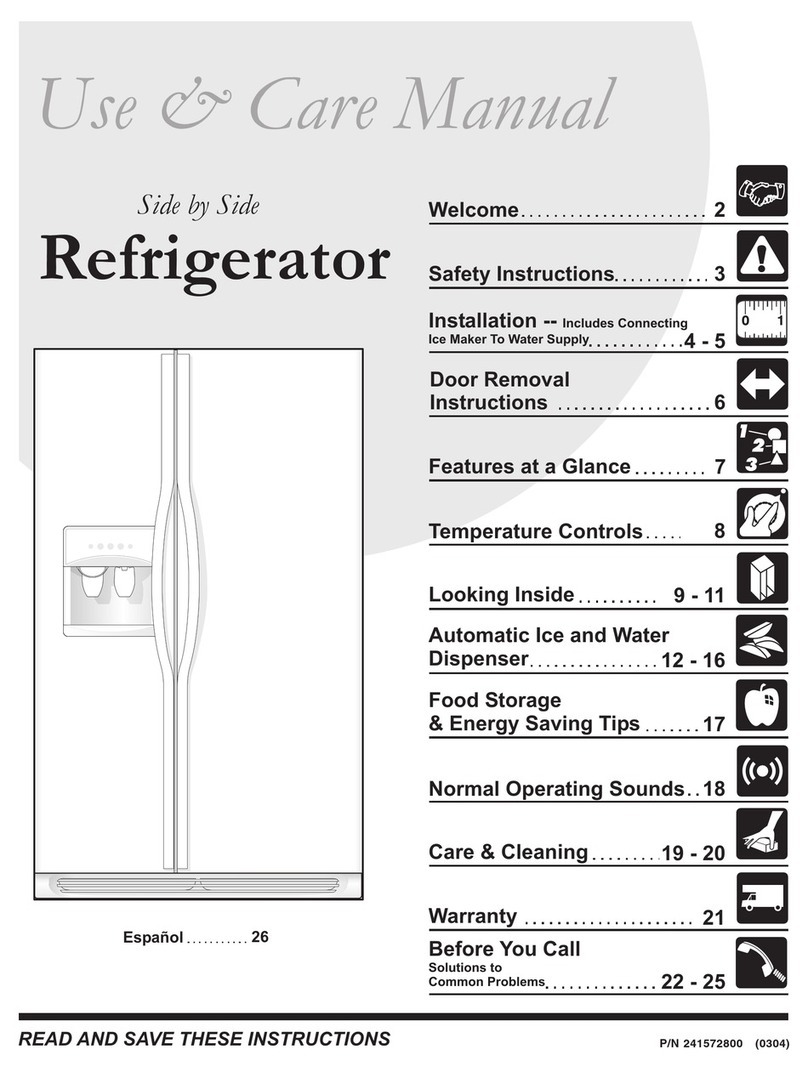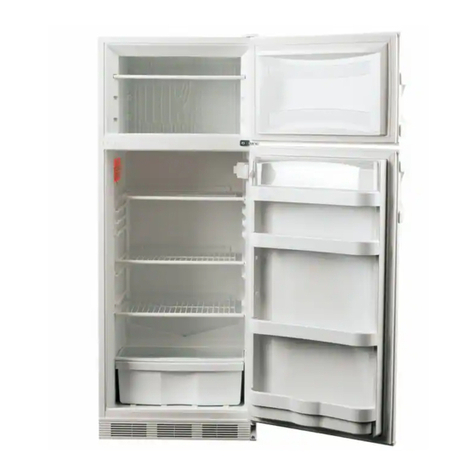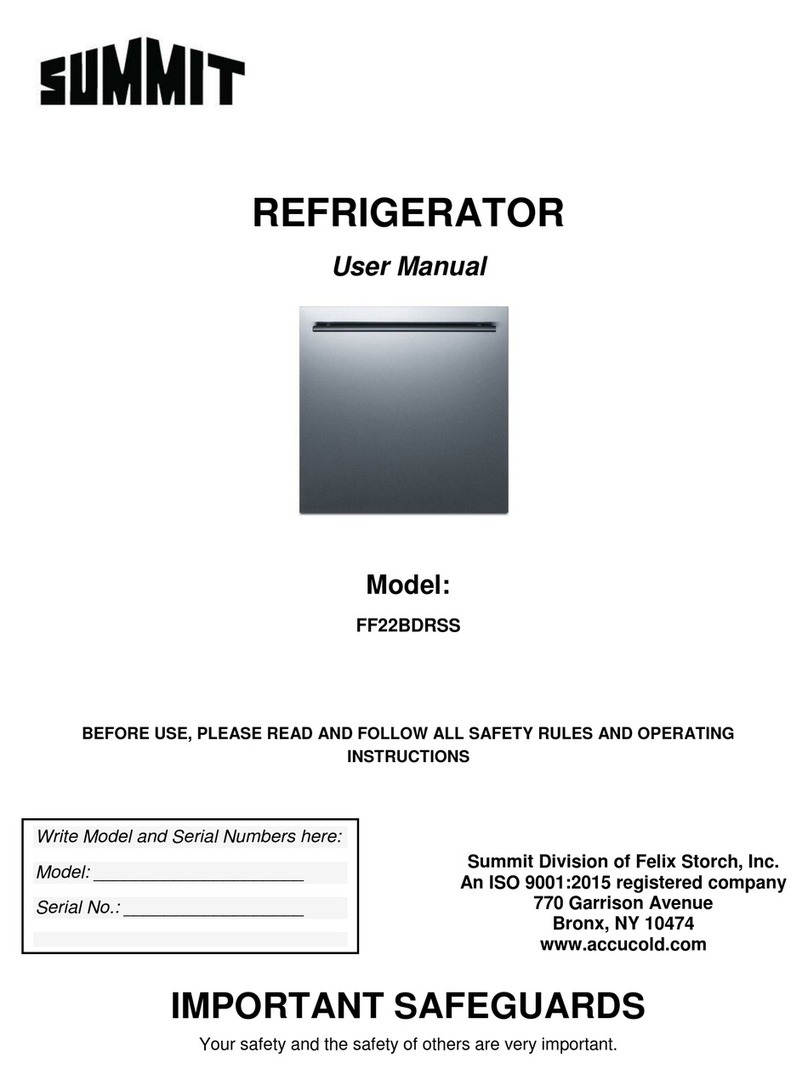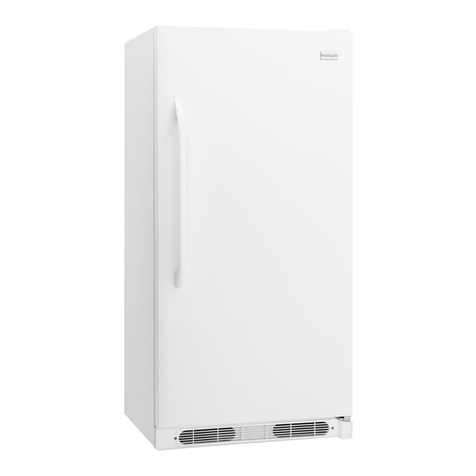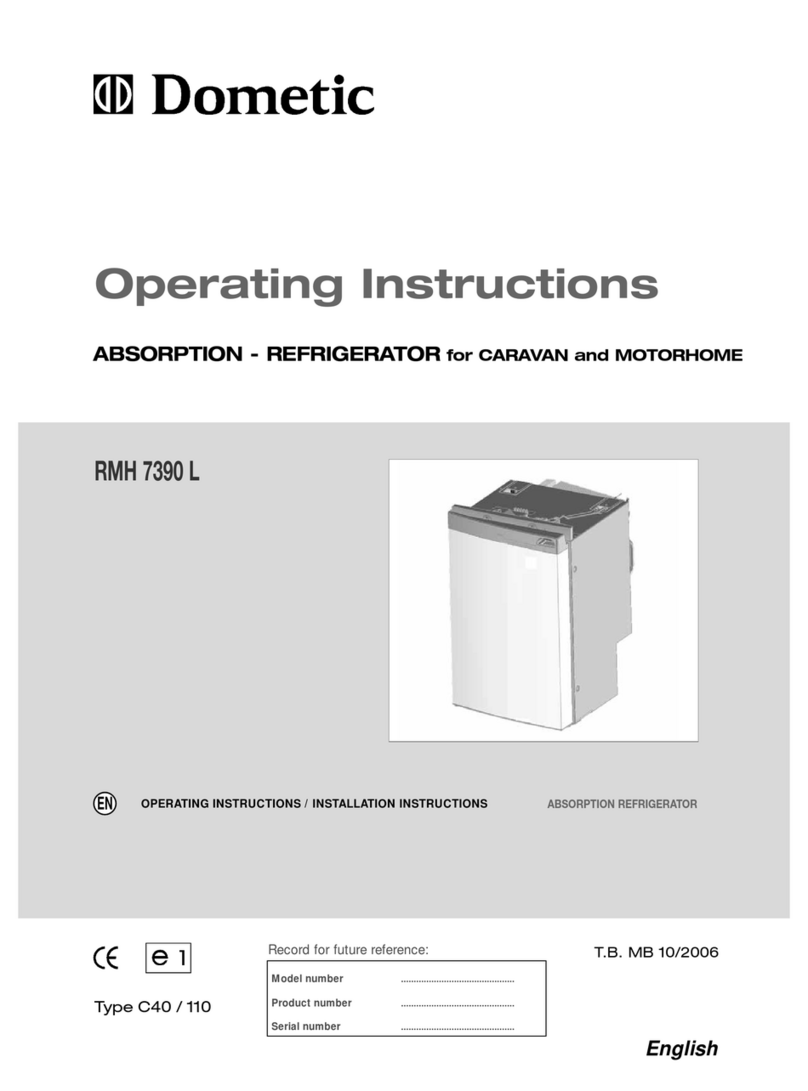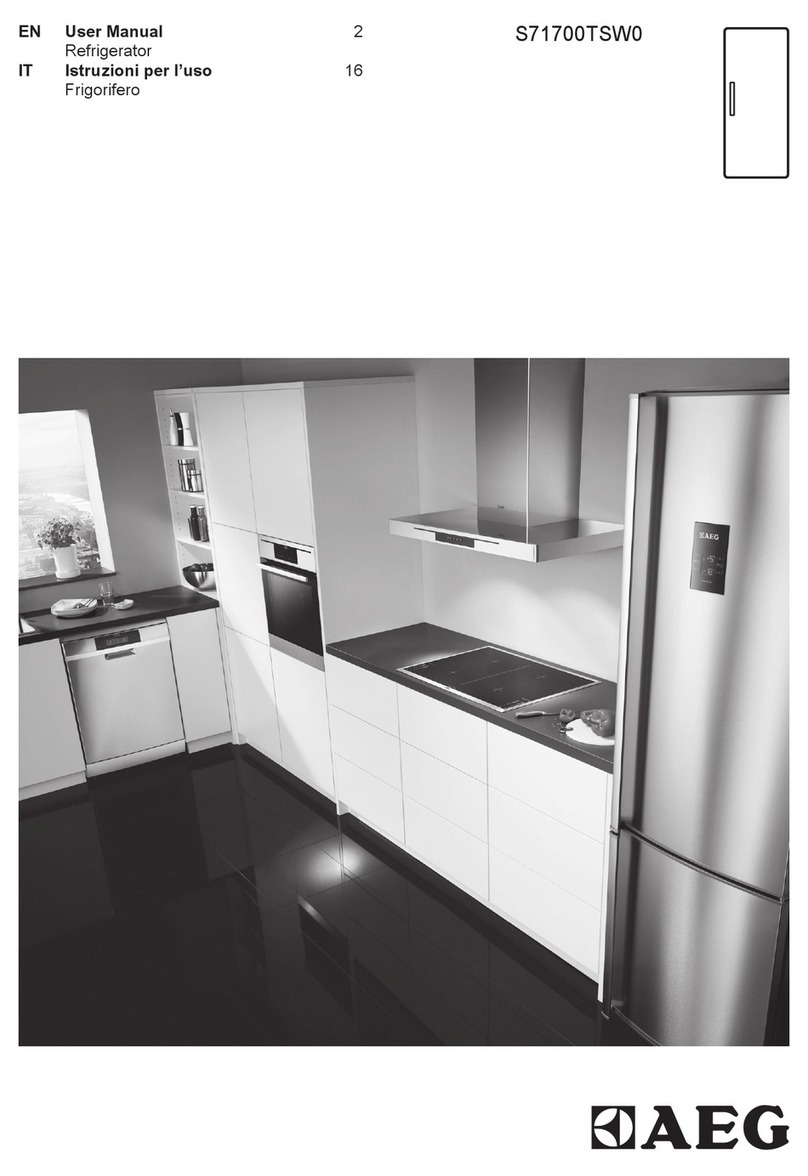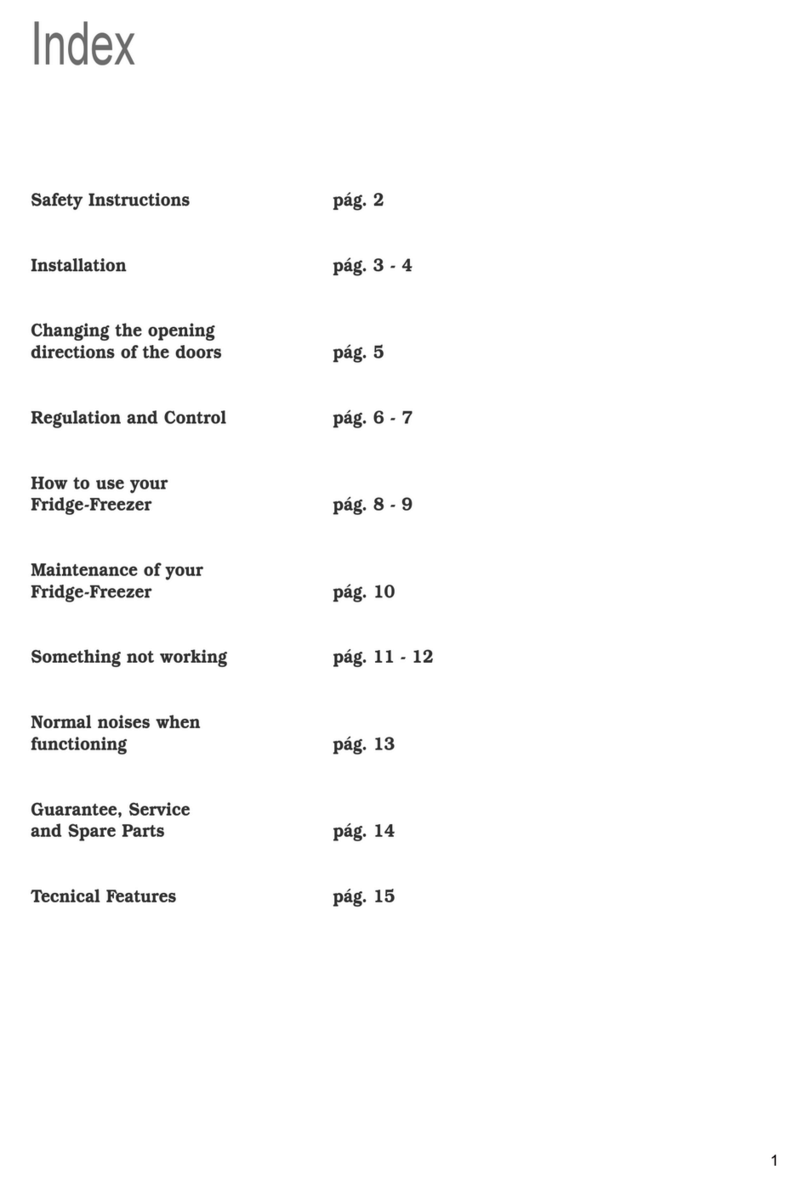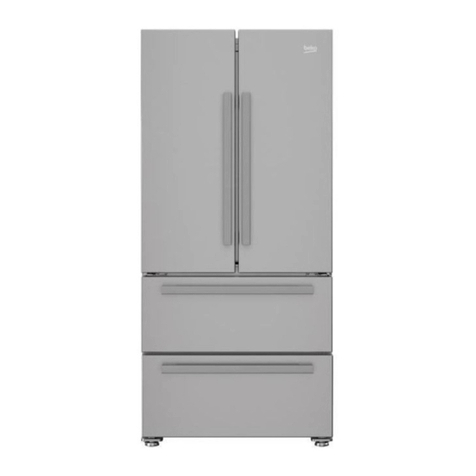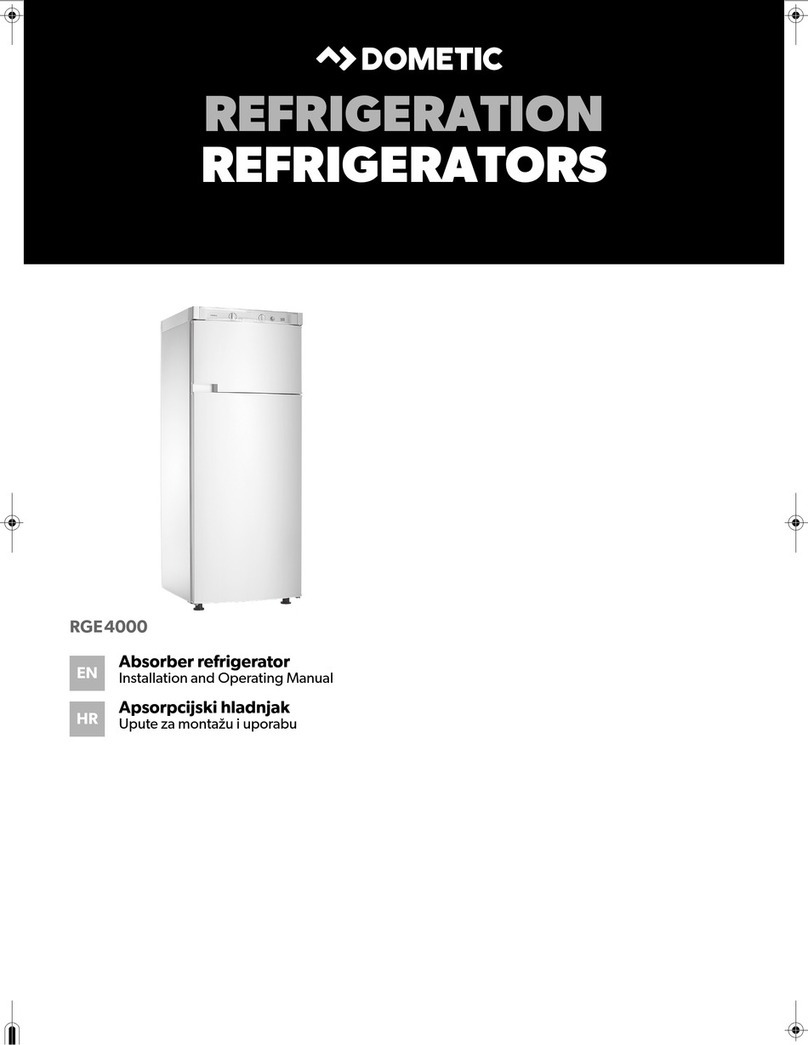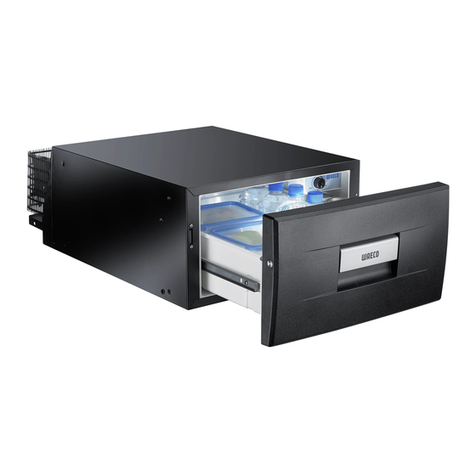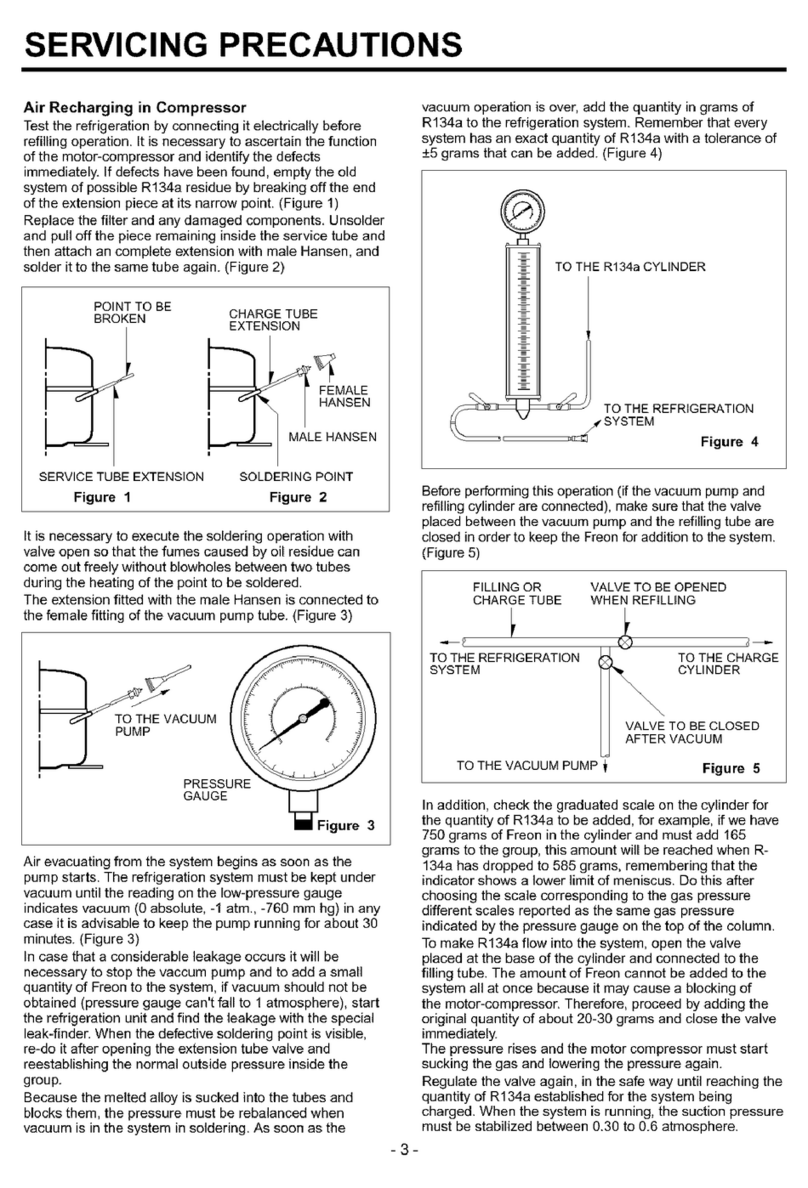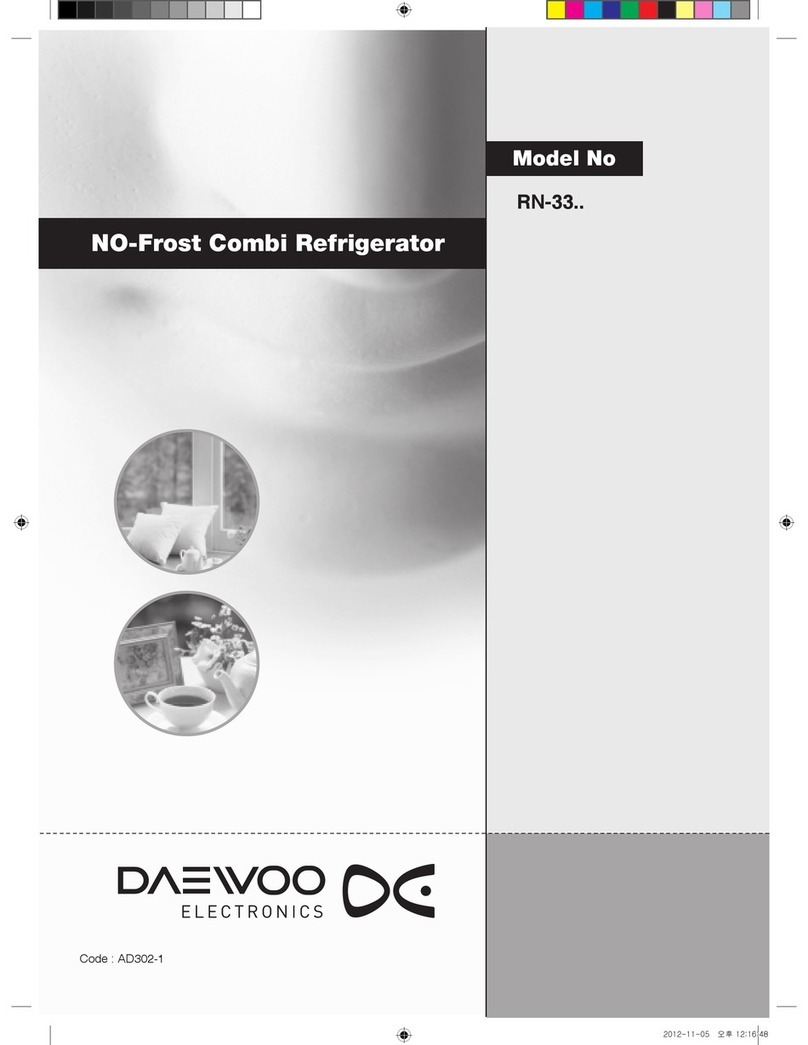Sunbeam SNR13TFOAW User manual

Guide to Refrigerators
For Single Door and Top Freezer Refrigerator Models

WARNING
General instructions
Read all instructions before use the refrigerator and save them for future references.
Please check and follow all given instructions according to the following explanations:
CAUTION
DANGER
Situations that must be considered to avoid deficiencies in performance, personal injuries and
damage to the product itself.
Situations that could cause deficiencies in performance, personal injuries and damage to the
product itself.
Situations that cause risk of damage to property, the product, or personal injuries (including death).
Old refrigerator to replace:
Be sure that old refrigerator does not become a trap for
children.
Remove doors or fix them to prevent children from opening
them.
Leave shelves in place so children may not climb inside.
Have refrigerant removed by a qualified service technician.
Do not store or use toxic materials, gasoline or other
flammable vapors and liquids in the vicinity of this or any
other appliance; the fumes can create a fire hazard or
explosion.
New refrigerator to install:
Most of the packing material of your refrigerator are
RECYCLABLE and DANGEROUS for children, so we
recommend you follow the following instructions:
Plastic bags are not toys, do not let children play with them
to avoid accidents due to suffocation
Properly dispose of the small plastic parts of packaging
and keep them away from children to avoid accidents due
to ingestion.
Elements of cardboard, paper and plastics should be
shipped to the respective places where this material is
recycled. Contact local recycling companies.
Base, cover and other packing elements are made of
STYROFOAM. This material is NOT RECYCLABLE,
please dispose of them accordingly.
DISPOSITION OF PRODUCT AND PACKING MATERIALS
Congratulations! You have purchased a high quality product with advanced technology.
Our commitment is to offer you the best service, as your satisfaction is our number one priority.
CAUTION
2

Before connecting your refrigerator, be sure to use a properly grounded wall outlet, and
verify the proper voltage and frequency for the electrical supply, as indicated on the
technical specifications label located over the back panel.(Fig N°1)
If the wall outlet does not fit the plug, do not under any circumstance modify or replace
it, and do not use a plug adapter without a grounding connection.
Do not use an extension cord to connect your refrigerator.
Performance may be affected if voltage varies by 10% or more, and it can damage the
compressor.
Never connect other appliances to the same wall outlet as your refrigerator to avoid
voltage variations.
Never unplug the refrigerator by pulling on the power cord. Always grip the plug firmly
and pull straight out from the receptacle to prevent damaging the power cord.
WARNING
25mm (1”)
25mm (1”)
13mm (1/2”)
75mm (3”)
32mm (1-1/4”)
Installation
Do not, under any
circumstances, cut,
remove or bypass
the grounding prong
GROUNDING TYPE
WALL OUTLET
POWER CORD WITH
3-PRONG
GROUNDED PLUG
For your safety, the power cord of your refrigerator is equipped with a three prong grounding plug.
It is your responsibility and obligation to provide an appropriate grounded wall outlet, installed by a
qualified technician, in accordance with local codes and ordinances.
ELECTRICAL REQUIREMENTS FOR SAFETY
If the power cord is damaged, it should be replaced by the manufacturer, service
technician or qualified person to prevent any risk of shock or injury.
Consult with a qualified technician if there are any doubts about refrigerator installation.
LOCATION
Your refrigerator is designed to operate in room temperatures between 10 C° and 43° C
under normal operating conditions.
.
In hotter and more humid conditions the refrigerator
runs less efficiently, for this reason place it in a well
ventilated location.
Your refrigerator should not be located in direct
sunlight or next to any heat generating appliances
such as a range or dishwasher. (Fig N°1)
Choose a place that is near a grounded electrical
outlet.
To provide air circulation around the cabinet and
electrical connection, allow the minimum clearances
as follows: 75mm (3”) of air space above the cabinet,
25mm (1”) each side, 32mm (1-1/4”) at the rear
between wall and condenser (black tubing coil) and
13mm (1/2”) from kitchen cabinets and front side of
refrigerator cabinet.(Fig N°2)
The refrigerator must be installed on a floor that is
level and strong enough to support it fully loaded.
Your refrigerator has been delivered fitted with rollers
to easily move it.(Fig N°3)
Your refrigerator is equipped with screw-type levelers
at the front, which can raise the front 5mm (3/16”) so
that the doors will slowly self close and also prevent
the doors from swinging.(Fig N°3)
FRONT
LEVELING
SCREWS
REAR
ROLLERS
CAUTION
(Fig N°1)
(Fig N°2)
(Fig N°3) 3

Turning the refrigerator control to 0 (OFF) turns off the compressor, but does not disconnect
the power to the lamp and other electrical components.
To turn off power to your refrigerator, you must unplug the power cord from wall outlet.
USE AND ADJUSTMENT OF TEMPERATURE CONTROLS
To ensure safe food storage, allow the refrigerator to operate with doors closed for at least 8 to 12 hours before loading it
with food.
The refrigerator has a temperature control located in the freezer trim (one door models) (Fig N°4-A) or in the control box at
top of fridge compartment (two doors models).(Fig N°4-B)
The control comes from factory set on 4 position (medium), but depending on ambient temperature and humidity you may
readjust it: 1 is the warmest position and 7 is the coldest position.(Fig N°4-C)
The operation time and internal temperatures will be affected by door opening frequency, environment temperature and
humidity, and loaded product conditions (entering temperature, quantity, containers, etc.).
0
1
2
3
4
5
6
7
O FF
M
R
A
W
O
I
R
F
S
O
N
E
M
M
A
S
F
R
I
O
U
I
D
E
M
M
E
D
O
M
I
C
O
L
D
E
S
T
0
1
2
3
4
5
6
7
OF
F
M
R
A
W
O
I
R
F
S
O
N
E
M
M
A
S
F
R
I
O
U
I
D
E
M
M
E
D
O
M
I
C
O
L
D
E
S
T
A)ONE DOOR MODELS B)TWO DOOR MODELS C)CONTROL KNOB
TWO DOOR MODELS
WARNING
( FIG N° 4)
4

This product is designed for household use; commercial applications will result in differences in
performance due to loading conditions, door openings and voltage variations.
Do not store or use toxic materialssuch as gasoline or other flammable vapors and liquids in the
vicinity of this or any other appliance, the fumes can create a fire hazard or explosion.
Use of refrigerator
WARNING
DANGER
Refrigerator - Semiautomatic Defrost
(One door):(Fig N°5-A)
The air cools when is in contact with surfaces of
evaporator in the freezer.
In this process, the moisture in the air and products
accumulates like frost on the walls, bottom and roof.
Begin defrosting by pushing the button in the
temperature control, and the refrigerator starts again
automatically.
Refrigerator with Top Mounted Freezer -
Partial Automatic Defrost (two doors):
(Fig N°5-B)
The air in the freezer cools when is in contact with
surfaces walls, bottom and roof; meanwhile air in the
fridge cools when is in contact with surfaces of the
evaporator plate.
The moisture in the air and products accumulate like
frost on all cold surfaces.
Begin defrosting by turning the temperature control
knob in the freezer compartment to the OFF position.
Refrigerator with Top Mounted Freezer -
Automatic Defrost (two doors with
MULTIFLOW system):(Fig N°5-C)
The air cools due to the circulation through the freezer,
and the configuration of ducts with a single fan gives an
efficient performance in both compartments.
The accumulated frost is defrosted with an automatic
heating system periodically.
The characteristics of different models of refrigerators:
Refrigerator Shelf
Refrigerator Shelf
Multiflow Cover
Ice Twister
Dairy Cover
Medium
Door Shelf
Eggs / Can Rack
Crisper Divider
Bottle Door Shelf
Ice Tray
Multiflow Cover
Control Box
Control Box Knob
Fan Cover Upper Cap Fan Cover
Deflector
Fan cover Cap
Upper Hinge
Cover
Ice Tray
Ice Twister
Dairy Cover
Refrigerator
Door Shelf
Eggs /Can Rack
Bottle Divider
Bottle Door Shelf
Refrigerator Shelf
Evaporator Plate
Upper Hinge,
Cover
Control Knob
Vegetables Crisper
Vegetables Crisper Cover
Freezer Door.
Refrigerator Shelf
Defrosting Tray
Large
Plastic Shelf
Dairy
Cover
Medium Freezer
Medium
Vegetables Crisper
Vegetables Crisper Cover
Crisper Divider
Vegetables Crisper
Vegetables Crisper Cover
Crisper Divider
Crisper Divider
Upper Hinge,
Cover
A)
B)
C)
(Fig N°5) 5

GENERAL ASPECTS
Heat of air and products into the refrigerator is absorbed by the refrigeration system.
Heat is released to the environment through the refrigeration system, it is normal for the front edge of cabinet and condenser
to be warm.
The frost accumulation varies with the relative humidity, temperature and use of the refrigerator.
It is normal for the gasket to make a slight hissing noise upon closing the door. This is due to the pressure difference between
the air inside the freezer and the air outside the freezer.
RECOMMENDATIONS TO OPTIMIZED EFFICIENCY AND PERFORMANCE
Do not leave the doors opened more than the necessary.
Verify the door gasket seals completely on the front surface.
Do not place in the refrigerator hot food, beverages or products.
If your fridge is switched off for any reason, wait 10 minutes before switching it back on, this will let the compressor equalize
before restarting.
Defrost the freezer when frost thickness is among 6 to 10mm.
DOOR ADJUSTMENT
If doors do not close correctly they can be adjusted moving the bushing in the hinge zones.(Fig N°6)
Adjust the door with a wrench so the gasket touches the cabinet evenly and the door lines up correctly.(Fig N°7)
The storage temperature must keep from 10° to 20°C.
Freezer operates most efficiently when is at least 2/3 full.
Do not pile frozen food around the fan cover in frost free
models, it can cause inadequate air circulation.
Freeze only small quantities of food at a time, using
covered and sealed containers.
Packages or containers of solid foods should have the air
removed and sealed tightly before freezing.
To freeze quickly place the food at the rear of bottom shelf.
The storage temperature must keep from 4° to 0°C.
Do not pile food around the air ducts, it can cause
inadequate air circulation. Keep them away from the cold
plate in the fridge of partial automatic defrost models to
avoid freezing and ice build up.
Store only small quantities of food at a time, using covered
and sealed containers.
Packages or containers of solid foods should have the air
removed and sealed tightly before storing.
To cool quickly place the food at the rear of crisper cover.
The recommendations for food storage are as follows:
Freezer Fridge
FOOD STORAGE
( FIG N° 6) ( FIG N° 7)
ADJUSTING
REFERENCE
LINES
ADJUSTING ZONES ADJUSTING MOVEMENT
6

The storage times will depend on factors such as quality of products (freshness), packing, expiration date, storing
temperature and humidity.
The indicated times (in weeks) must be condsidered:
Maintenance
Always unplug the electrical power cord from wall outlet before cleaning and other activity related
to maintenance.
Turning the refrigerator control to 0 (OFF) turn off the compressor, but does not disconnect the
power to the lamp and other electrical components.
To turn off power to your refrigerator, you must unplug the power cord from wall outlet.
CAUTION
Keep the interior of the refrigerator clean to help prevent food from being contaminated during
storage.
Wipe up any spills immediately and clean both sections at least twice a year.
Never use metallic scouring pads, brushes, abrasive cleaners, strong alkaline solutions or
solvents on any surface.
WARNING
When moving the refrigerator pull it straight out.
Do not shift the refrigerator from side to side as this as this may gouge the floor covering.
Damp objects stick to cold surfaces, do not touch refrigerated surfaces with wet or damp hands.
To avoid damage and help the refrigerator to run efficiently as possible, clean the condenser periodically every 4 months and
never use it as a dryer (cloth, shoes, etc.).
Do not use razor blades or other sharp instruments which can scratch the appliance surface when removing adhesive labels.
Any glue left from tape or labels can be removed with a mixture of warm water and mild detergent, or touch the glue residue
with a sticky side of tape you have already removed.
Do not remove the serial plate.
The amount and kind of food stored determines how often cleaning should be carried out.
To start unplug the power cord and remove the shelves and accessories from the cabinet and doors,and follow the below
indicated products:
PART WHAT TO USE TIPS AND PRECAUTIONS
Door Gaskets Soap and water. Wipe with a clean soft cloth.
Clean with a toothbrush.
Exterior and handles Soap and water. Do not use commercial household cleaners, ammonia or
alcohol to clean handles.
Do not use metallic or synthetic abrasive fibers, alkaline
cleaners, highly perfumed strong smelling cleaners or
solvents on any part of your refrigerator
12 24 4 8 4 3 2 1
1 2 2 2 3 2 3 1
Baked Poultry Meat Fish Dairy Fruits Eggs VegetablesGrupos
7

Condenser coils Vacuum cleaner.
Soft brush.
Use the dusting tool attachment on your vacuum
cleaner or a brush to remove dust build up on the
condenser coils (black tubes and wires) attached to the
back.
Compressor base Soap and water.
Vacuum attachment
Soft brush
Mild liquid spay
Vacuum or brush dust from base and wipe with sudsy
cloth or sponge.
Rinse and dry.
Turn the power off at the wall outlet before replacing the lamp.
Wear gloves as protection against possible broken glass.
Remove all surrounding elements, pans and correspondent covers and shields.
Unscrew and replace the old lamp with a new appliance lamp of the same voltage and power (15 W Max).
Replace the shields and additional elements again.
Plug the refrigerator back into the wall outlet.
( FIG N° 9)
REPLACEMENT OF THE INTERIOR LAMP
PART WHAT TO USE TIPS AND PRECAUTIONS
Glass Shelves Soap and water.
Vacuum attachment
Mild liquid spay
Allow glass to warm to room temperature before
immersing in warm water.
Rinse and dry.
Interior, door liner and its
elements.
Soap and water.
Baking soda and water.
Add 2 tablespoons of baking soda to 1 quart of warm
water.
Wipe the interior surfaces with warm water and soft
soap cleaner or baking soda dissolved in warm water.
To help remove “old stale refrigerator” smell add a few
drops of vanilla extract to the water before cleaning.
Be sure to wring excess water out of the sponge or
cloth when cleaning in the control area, light bulb or
any electrical part.
Wash the shelves in warm water, and soft soap, rinse
in clean water and dry by hand; do not put them into
the dishwasher.
Wipe and dry.
Defrost water pan. Soap and water. Two door models have the pan located on top of the
compressor compartment at the bottom rear of refrigerator.
Move away from wall and unplug from
the wall outlet.
the refrigerator the
Be careful with tubing surrounding the pan as it may
be hot.
Wipe water pan with damp cloth or sponge.
( FIG N° 8)
8

SEMIAUTOMATIC DEFROST (ONE DOOR)( FIG N° 10)
These models are equipped with semi-automatic defrosting system
(Push button).
They operate with a red button placed in the center of the temperature
control knob.
Press the red button once a week, during the night for your convenience,
this will increase the performance and save energy, the temperature
control can remain at its normal setting.
The ice will be eliminated from the freezer, and the water will be
collected in the tray below.
Once the freezer is free of ice, the refrigerator will start again
automatically and will reach the previously selected temperature.
Empty the tray of water and scraped-off ice.
In order to avoid condensation in this tray, we recommend you do not let
the frost build up; this will block the air flow in your refrigerator.
PAR IAL AUTOMATIC DEFROST (TWO DOORS)T( FIG N° 11)
Ensure that the defrosting of your freezer is carried out as quickly as
possible.
Remove all frozen food and wrap it in several layers of paper, place in
the fridge compartment or a cool environment, e.g. insulated ice chest.
Switch the power off at the wall, the temperature control can remain at its
normal setting.
Reduce defrosting time by placing a bowl of warm water in the freezer
compartment and leaving the door open.
Keep the refrigerator compartment door closed.
Empty out the water and scraped-off ice.
Wipe out and dry the freezer.
Replace the frozen food.
Switch the refrigerator on
DEFROST
MANUAL
DEFROST
AUTOMATIC
DEFROST
PUSH
BUTTON
DEFROSTING FREEZER
It is recommended that the freezer be defrosted when the frost is among 6 to 10 mm thick, to avoid excessive
accumulations of ice which affect performance and efficiency.
Do not use knives or any other sharp instrument to remove the ice, otherwise the freezer surface may become irreversibly
damaged.
Use a plastic spatula to remove any loose ice.
SEMIAUTOMATIC
In the two doors models use a flat screwdriver of 5 mm
width or similar to remove the correspondent shields
(control box and fan cover)
8
A) DEFROSTING TRAY B) CONTROL BOX C) FAN COVER
In one door models
remove the defrost pan and replace the lamp.
( FIG N° 9)
( FIG N° 10)
( FIG N° 11)
9

ADVERTENCIA
Instrucciones Generales
¡Felicidades! Usted ha adquirido un producto de gran calidad y tecnología de avanzada.
Nuestro compromiso es brindarle el mejor servicio porque su satisfacción es nuestra prioridad número uno.
Lea todas las instrucciones antes de utilizar su refrigerador y consérvelas para futuras referencias.
Ponga especial atención y siga todas las instrucciones dadas según se indican en las siguientes explicaciones:
PRECAUCION
PELIGRO
Situaciones que deben considerarse para evitar deficiencias en el desempeño, daños personales y
del producto.
Situaciones que pueden causar deficiencias en el desempeño, lesiones personales y del
producto.
Situaciones que causan eminentes riesgos de daños al producto, la propiedad, lesiones personales
e incluso la muerte.
2
PRECAUCION DISPOSICIÓN DEL PRODUCTO Y MATERIAL DE EMPAQUE
Sobre el producto a sustituir:
Asegúrese que el refrigerador que será sustituido, no se
convierta en una trampa de juego para los niños.
Retire la(s) puerta(s) del mismo o fíjela(s) de modo que
ellos no puedan abrirla(s).
Deje los estantes y parrillas en su lugar para impedir el fácil
acceso dentro de la unidad.
Asegúrese que un técnico calificado extraiga el líquido
refrigerante.
No almacene materiales tóxicos ni líquidos o gases
inflamables cerca de éste o cualquier otro
electrodoméstico, los vapores pueden causar incendios o
explosiones.
Sobre el producto a desempacar:
El empaque de su refrigerador está compuesto en su
mayor parte por MATERIALES RECICLABLES pero
también PELIGROSOS para los niños, de tal forma que le
recomendamos seguir las siguientes indicaciones:
Las bolsas de plástico no son juguetes, no deje que los
niños jueguen con ellos para evitar accidentes por
sofocación.
Deshágase apropiadamente de las partes pequeñas
resultantes del empaque, y MANTÉNGALAS ALEJADAS
DEL ALCANCE DE LOS NIÑOS PARA EVITAR
ACCIDENTES POR INGESTIÓN.
Los elementos de cartón corrugado, papel y plástico
pueden ser llevados o enviados hasta las compañías
dedicadas al reciclaje.
Contacte las empresas más cercanas.
La base, el cobertor superior, y otros elementos de
embalaje son fabricados en POLIESTIRENO EXPANDIDO,
el cual NO ES RECICLABLE, por tal motivo deséchelos
adecuadamente.

TORNILLO
NIVELADOR
FRONTAL
RODILLO
TRASERO
25mm (1”)
25mm (1”)
13mm (1/2”)
75mm (3”)
32mm (1-1/4”)
Instalación
En ninguna circunstacia
corte, elimine o desvíe
la clavija de conexión
a tierra.
RECEPTACULO DE PARED
CON CONEXION A TIERRA
CABLE DE ALIMENTACION
DE 3 CLAVIJAS
CON CONEXION A TIERRA
PRECAUCIONPara su seguridad, este refrigerador está equipado con un enchufe provisto de puesta a tierra.
Es responsabilidad y obligación del cliente instalar; a través de un electricista o técnico calificado,
un tomacorriente aterrizado de acuerdo al código eléctrico de su país.
REQUERIMIENTOS ELÉCTRICOS DE SEGURIDAD
Antes de conectar su refrigerador, asegúrese que el tomacorriente este sea del
voltaje y frecuencia indicadas en la placa de características técnicas que se
encuentra en el respaldo del refrigerador.
Si el enchufe de su refrigerador no coincide o no calza con el tomacorriente, bajo
ninguna circunstancia debe modificar o reemplazar el enchufe, no utilizar
adaptadores para tomacorriente que no posean toma a tierra.
No utilice una extensión eléctrica para conectar este refrigerador
Las variaciones de voltaje de 10% o más afectarán el adecuado funcionamiento del
refrigerador, e incluso el daño completo del compresor.
Nunca instale otros equipos en el mismo tomacorriente para evitar variaciones en el
voltaje.
Nunca tire bruscamente el cable de alimentación para desenchufar el refrigerador,
sujete el enchufe firmemente para sacarlo del receptáculo para evitar daños en el
cable.
Si el cordón de alimentación es dañado, éste debe ser reemplazado por el fabricante
o su agente de servicio autorizado.
Consulte con un técnico calificado, preferentemente autorizado, si tiene dudas
respecto a lo anterior.
UBICACION
ADVERTENCIA Su refrigerador está diseñado para que trabaje a una temperatura ambiente entre 10°C y
43°C bajo condiciones de operación normal.
(FIGURA N° 1)
( VER FIGURA N° 1)
(FIGURA N° 2)
(FIGURA N° 3)
En condiciones o ambientes calientes el refrigerador
trabaja con menos eficiencia, por esta razón ubíquelo
en una zona bien ventilada.
El espacio a localizar el refrigerador debe estar cerca
de un tomacorriente correctamente aterrizado.
Ubique su refrigerador fuera del alcance de la luz
solar directa y de aparatos que generen calor; tales
como una estufa o un lavaplatos.
Para facilitar la circulación de aire adecuada
alrededor de su refrigerador y las conexiones
eléctricas, deje al menos los siguientes espacios : 75
mm de sobre el gabinete, 25 mm a cada lado, 32 mm
entre la pared y el condensador (tuberías negras en
la parte posterior) y 13 mm del borde frontal del
gabinete del refrigerador al borde externo del mueble.
El refrigerador debe descansar sobre un piso de
superficie nivelada y que resista su peso
completamente cargado.
Para facilitar el movimiento de su refrigerador, éste se
encuentra equipado con ruedas traseras.
Para nivelar el refrigerador se deben girar los tornillos
niveladores frontales, los cuales pueden elevarse
unos 5mm hasta que quede ligeramente inclinado
hacia atrás; esta posición ayuda a que las puertas se
cierren por sí mismas y evita que se abran solas.
( VER FIGURA N° 1)
( VER FIGURA N° 2)
( VER FIGURA N° 3)
( VER FIGURA N° 3)
3

La posición 0 (OFF) del control apaga el compresor y el refrigerador deja de enfriar, pero no
desconecta la energía eléctrica hacia la lámpara ni otros componentes eléctricos.
Para desconectar totalmente la energía eléctrica debe desenchufarse del tomacorriente por
completo.
USO Y AJUSTE DE CONTROLES DE TEMPERATURA
ADVERTENCIA
Para garantizar el almacenamiento correcto de los alimentos, deje funcionar el refrigerador con la(s) puerta(s) cerrada(s)
por un período mínimo de 8 a 12 horas antes de colocar alimentos en el interior.
El refrigerador cuenta con un único control de temperatura localizado en el marco del congelador (modelos de una puerta)
en la caja de control en el techo del compartimiento de enfriador (modelos de dos puertas).
El refrigerador viene ajustado de fábrica en la posición 4 (medio), pero dependiendo de la temperatura y la humedad
ambiental, se debe ajustar según los requerimiento de uso considerando que 1 es la posición menos fría y 7 es la
posición más fría.
El tiempo de funcionamiento del refrigerador y la temperatura interna del refrigerador se verán afectados por la frecuencia
de aperturas de las puertas, la temperatura ambiente del lugar donde se encuentre y la condición de los productos
almacenados (temperatura de entrada, cantidad, recipientes, etc.).
( VER FIGURA N° 4-A) o
( VER FIGURA N° 4-B)
( VER FIGURA N° 4-C)
0
1
2
3
4
5
6
7
O FF
M
R
A
W
O
I
R
F
S
O
N
E
M
M
A
S
F
R
I
O
U
I
D
E
M
M
E
D
O
M
I
C
O
L
D
E
S
T
0
1
2
3
4
5
6
7
OF
F
M
R
A
W
O
I
R
F
S
O
N
E
M
M
A
S
F
R
I
O
U
I
D
E
M
M
E
D
O
M
I
C
O
L
D
E
S
T
A)MODELOS UNA PUERTA B) MODELOS DE DOS PUERTAS C) PERILLA CONTROL
MODELO DE DOS PUERTAS
( VER FIGURA N° 4)
4

Uso del refrigerador
Refrigerador de Deshielo Semiautomático
(una puerta):
El aire se enfría por el contacto con las superficies del
congelador.
En este proceso, la humedad contenida en el aire y los
productos se acumula como escarcha en sus paredes y
techo.
El deshielo se inicia manualmente presionando el botón
del control de temperatura y la marcha del refrigerador se
reinicia automáticamente.
( VER FIGURA N° 5-A)
Refrigerador con Congelador en la parte
Superior de Deshielo Parcialmente
Automático (dos puertas):
El aire del congelador se enfría por el contacto con sus
paredes, techo y piso; mientras que el aire del enfriador se
enfría por el contacto con la placa fría.
La humedad del aire y los productos se acumula en las
superficies frías como escarcha.
El deshielo en el congelador es manual, ajustando en OFF
el control de temperatura, mientras que la placa del
enfriador es automática a través de una elemento
calefactor detrás de ésta.
( VER FIGURA N° 5-B)
Refrigerador con Congelador en la parte
Superior de Deshielo Automático (dos
puertas):
El aire se enfría por la circulación de este a través del
congelador, y gracias a la configuración adecuada de
ductos con un sólo abanico, permite el manejo eficiente y
eficaz del aire en ambos compartimentos.
La escarcha acumulada (no visible) se deshiela
periódicamente con un sistema de calefacción
automática.
( VER FIGURA N° 5-C)
Las características de los diferentes modelos de refrigeradores se resume a continuación:
ADVERTENCIA Este producto está diseñado para uso doméstico, pero si se utiliza en aplicaciones comerciales
puede presentar diferencias en el desempeño, por las condiciones de carga, frecuencia de apertura
de puerta(s) y voltaje de alimentación.
No almacene materiales tóxicos ni líquidos o gases inflamables dentro y/o cerca de éste o
cualquier otro electrodoméstico, los vapores pueden causar intoxicaciones,incendios y/o
explosiones.
PELIGRO
Parrilla Media Congelador
Parrilla Enfriador
Bandeja de Carnes
Cobertor Bandeja de Verduras
Separador Bandeja
Bandeja de Verduras
Conjunto Ice Twister
Cobertor
Mantequillera
Estante
Enfriador Medio
Huevera / Portalatas
Separador Estante
Estante de Botellas
Bandeja de Hielo
Cobertor Multiflujo
Caja de Control
Perilla Caja de Control
Cubierta Superior Cobertor Abanico Deflector
Cobertor Abanico
Cobertor Abanico
Cobertor
Bisagra Superior
Bandeja de Hielo
Cobertor Bandeja de Verduras
Bandeja de Verduras
Conjunto Ice Twister
Cobertor Mantequillera
Estante Enfriador
Huevera / Portalatas
Separador Estante
Estante de Botellas
Parrilla Enfriador
Placa Evaporador
Cobertor Bisagra
Superior
Perilla Control
Temperatura
Bandeja de Verduras
Cobertor Bandeja de Verduras
Puerta Congelador
Parrilla Enfriador
Bandeja Recolectora de Agua
Barandilla
Cobertor
Mantequillera
Separador Bandeja
Parrilla Media
Congelador
Cobertor Bisagra Superior
Separador Bandeja
A)
B)
C)
( VER FIGURA N° 4)
5

GENERALIDADES
El calor del aire y de los productos que están dentro del refrigerador se absorbe y elimina a través del sistema de
refrigeración.
Al disiparse el calor hacia el exterior por medio del sistema de refrigeración, es normal que el borde frontal del gabinete
y el condensador estén calientes.
La acumulación de escarcha varía con las condiciones ambientales, como la humedad relativa y la temperatura,
además del uso del refrigerador
Cuando las puertas se cierran, es normal escuchar un ruido similar a un silbido, esto se genera por las diferencias de
presión entre el aire dentro del refrigerador y el exterior.
RECOMENDACIONES PARA OPTIMIZAR LA EFICIENCIA Y DESEMPEÑO
No deje abierta la puerta de su refrigerador más del tiempo necesario
Verifique que el empaque magnético de la puerta selle adecuadamente.
No introduzca alimentos o bebidas en su refrigerador más calientes que la temperatura ambiente.
Si su refrigerador es desconectado por alguna razón, espere 10 minutos antes de volverlo a conectar, esto permitirá
que el compresor se estabilice antes de reiniciar su marcha
Elimine con regularidad la escarcha del congelador, según el modelo, cuando ésta tenga un espesor entre 6 y 10 mm.
AJUSTE DE LAS PUERTAS
Si la(s) puerta(s) no cierra(n) ni ajusta(n) adecuadamente, se puede(n) ajustar con el giro del buje en la zona de la
bisagra.
Con la llave incluida en su refrigerador ajuste el buje de la(s) puerta(s), hasta que el empaque magnético toque el
gabinete de modo uniforme y la(s) puerta(s) quede (n) alineada(s) con los bordes del gabinete.
( VER FIGURA N° 6)
( VER FIGURA N° 7)
La temperatura de almacenaje debe mantenerse de 10° a -
20°C.
El congelador mantiene su eficiencia con cargas mayores a
2/3 de su capacidad.
No acumule alimentos alrededor del ventilador, permitiendo
una adecuada circulación del aire.
Congele únicamente pequeñas cantidades de alimento, en
recipientes bien tapados para productos frescos o bolsas con
cierres herméticos.
Remueva el aire que contienen los empaques o recipientes
con alimentos sólidos antes de introducirlos.
Los alimentos se congelan más rápidamente sobre el fondo
del congelador.
La temperatura de almacenaje debe mantenerse de 4° a
0°C.
No acumule alimentos alrededor de los ductos de aire ni en
contacto con la placa de enfriamiento, para permitir una
adecuada circulación del aire, evitar el congelamiento y la
formación de hielo.
Guarde pequeñas cantidades de alimento, en recipientes
bien tapados para productos frescos o bolsas con cierres
herméticos.
Remueva el aire que contienen los empaques o recipientes
con alimentos sólidos antes de introducirlos.
Los alimentos se enfrían más rápidamente sobre el cobertor
de la bandeja de verduras.
ALMACENAMIENTO DE ALIMENTOS
Las recomendaciones de almacenaje se resumen a continuación:
Congelador Enfriador
LINEAS DE
REFERENCIA
ZONAS DE AJUSTE MOVIMIENTO DE AJUSTE
( FIGURA N° 6) ( FIGURA N° 7)
6

Los tiempos de almacenamiento dependerán de factores como la calidad del producto (frescura), empaque, recipientes,
fecha de caducidad, temperatura y humedad de almacenaje.
Los tiempos (en semanas) que se indican no deben ser sobrepasados:
12 24 4 8 4 3 2 1
1 2 2 2 3 2 3 1
Horneados Aves CarnesCarnes Pescado Lacteos Frutas Huevos LegumbresGrupos
Mantenimiento
Siempre desenchufe el cable de alimentación eléctrica de la toma de corriente de pared antes de
la limpieza y cualquier actividad relacionada con el mantenimiento del refrigerador.
Al girar el control de temperatura a la posición 0 (OFF) se apaga el compresor y el refrigerador
deja de enfriar, pero no desconecta la energía eléctrica hacia el foco ni hacia otros componentes
eléctricos.
Para desconectar completamente la energía eléctrica hacia el refrigerador, usted debe
desenchufarlo del tomacorriente.
PRECAUCION
Mantenga su refrigerador y congelador limpios para evitar la aparición de olores desagradables y
prevenir la contaminación de los alimentos.
Limpie cualquier derrame inmediatamente y limpie ambos compartimientos por lo menos dos
veces al año.
Nunca utilice esponjas para restregar, cepillos, limpiadores abrasivos ni soluciones alcalinas
fuertes ni solventes para limpiar las superficies.
ADVERTENCIA
Al mover el refrigerador, sáquelo directamente hacia fuera.
No mueva el refrigerador de lado a lado porque podría rasgar o levantar la cubierta del piso.
Los objetos húmedos se adhieren a las superficies metálicas frías, por lo que no toque las superficies refrigeradas con
las manos mojadas o húmedas.
Para evitar daños y lograr que el refrigerador funcione con la mayor eficiencia posible, limpie el condensador
periódicamente.(2 veces al año)
No utilice hojas de afeitar ni otros instrumentos afilados para quitar las etiquetas adhesivas porque pueden dañar la
superficie del refrigerador.
Cualquier residuo de pegamento de etiquetas o cintas puede eliminarse con una mezcla de agua tibia y detergente
suave, también puede levantar el residuo de goma con la parte adhesiva de la cinta que se haya quitado.
No quite la placa de identificación.
Para limpiarlo desconéctelo del tomacorriente, remueva las parrillas del gabinete y los estantes de las puertas, y utilice los
productos recomendados a continuación:
Empaque magnético de
las puertas.
Jabón y agua. Limpie las juntas con un paño suave y limpio.
El empaque magnético de las puertas con un cepillo de
dientes.
PARTE A LIMPIAR DEBE UTILIZAR CONSEJOS Y PRECAUCIONES
Exterior y maniguetas Jabón y agua. No utilice limpiadores comerciales para uso doméstico ni
alcohol para limpiar las manillas.
Nunca utilice fibras metálicas o sintéticas abrasivas,
soluciones alcalinas, solventes o limpiadores altamente
perfumados sobre la superficie de su refrigerador.
7

Serpentín del
condensador
Aspiradora.
Brocha de cerdas suaves
Utilice la boquilla para quitar polvo de la aspiradora para
quitar el excuso de polvo de los serpentines del
condensador (tubos negros y cableado) que están en la
parte posterior.
Base del compresor Jabón y agua
Aerosol líquido suave
Accesorio de aspiradora
Brocha de cerdas suaves
Aspire o cepille la base y límpiela con un paño o esponja
impregnada de agua jabonosa.
Enjuague y seque.
PARTE A LIMPIAR DEBE UTILIZAR CONSEJOS Y PRECAUCIONES
Bandeja de agua
descongelada.
Jabón y agua En los modelos de dos puertas se encuentra la bandeja
de agua en la parte posterior.
Para limpiarla retire el refrigerador de la pared y
desconéctelo del tomacorriente.
Tenga precaución con los serpentines internos y
circundantes pues pueden estar calientes.
Extraiga el agua con una esponja o trapo.
Lávela con agua y un detergente o desinfectante, luego
enjuáguela y séquela.
Interior y revestimiento de
las puertas
Jabón y agua
Bicarbonato de soda y agua
Limpie el interior con una solución de agua tibia y
bicarbonato de sodio (disuelva una cucharadita de
bicarbonato de sodio por cada medio litro de agua.)
Luego enjuague y seque el refrigerador, asegurándose de
eliminar los excesos de agua con una esponja o trapo,
especialmente en el área del control de temperatura y la
lámpara.
Para eliminar los malos olores, agregue unas gotas de
esencia de vainilla a la solución de agua y bicarbonato de
sodio antes de aplicarla.
Anaqueles de vidrio Jabón y agua
Aerosol líquido suave
Accesorio de aspiradora
Deje que el vidrio adquiera la temperatura ambiente antes
de sumergirlo en el agua tibia.
Desconecte el refrigerador del tomacorriente antes de reemplazar la lámpara dañada.
Utilice guantes para evitar cortarse si se rompe el bulbo de la lámpara.
Remueva los elementos circundantes, bandeja y cobertores correspondientes.
Desenrosque y reemplace la lámpara por otra del mismo voltaje y potencia (15 W máximo).
Una vez remplazada la lámpara, proceda de forma inversa en el montaje de las partes removidas.
Enchufe de nuevo el refrigerador al toma corriente.
( VER FIGURA N° 9)
REMPLAZO DE LA LAMPARA INTERIOR
( FIGURA N° 8)
8

7
8
BANDEJA RECOLECTORA CAJA DE CONTROL COBERTOR ABANICO
En los modelos de una puerta remueva la bandeja
de deshielo y retire la lámpara.
En los modelos de dos puertas, utilice un desatornillador
plano de 5 mm o similar para remover los cobertores
correspondientes, tanto en la caja de control del enfriador
como en el cobertor de abanico de congelador.
A) B) C)
( VER FIGURA N° 9)
MODELOS DE UNA PUERTA (Deshielo semiautomatico)
Su refrigerador está equipado con un sistema de descongelación
semiautomático (PUSH BUTTON).
Este sistema funciona por medio de un BOTÓN ROJO ubicado en el
centro de la perilla del control de temperatura.
Se recomienda presionar el botón rojo cada semana, y por la noche para
su comodidad.
El líquido se depositará en la bandeja situada debajo del congelador.
Asegúrese de eliminar el agua de la bandeja antes de que llene hasta el
borde.
Una vez que el congelador esté libre de escarcha, el refrigerador
automáticamente volverá a su operación normal y al nivel de
temperatura que usted previamente había establecido
Para evitar que se produzcan gotas en la parte inferior de la bandeja, le
recomendamos no permitir un crecimiento desmedido de la escarcha en
el congelador de su refrigeradora.
MODELOS DE DOS PUERTAS (Deshielo parcialmente
automático
Asegúrese de que el agua producida por el deshielo sea retirada tan
rápido como sea posible de su congelador.
Antes de iniciar el proceso de descongelación, retire del congelador
todos los alimentos y envuélvalos con varias capas de papel, luego
colóquelos dentro del enfriador o en una hielera para picnic.
Desconecte el refrigerador de tomacorriente, el control de temperatura
puede permanecer en la posición establecida.
Para reducir el tiempo de descongelación, ubique un recipiente con agua
caliente dentro del congelador y mantenga la puerta del mismo abierta.
La puerta del enfriador si debe permanecer cerrada.
Antes de reubicar los alimentos en el congelador, asegúrese de eliminar
completamente el agua de deshielo y seque el congelador.
Conecte de nuevo su refrigerador al tomacorriente.
Se recomienda descongelador su refrigerador cuando la escarcha tenga un espesor entre los 6 y los 10 mm, para
evitar las acumulaciones excesivas de escarcha y deficiencias en el desempeño y eficiencia.
No utilice cuchillos o cualquier otro instrumento afilado para remover el hielo, de otra forma la superficie del congelador
puede ser dañada.
Utilice una espátula plástica para remover cualquier sobrante de hielo en el congelador.
DESHIELO DEL CONGELADOR ( Solo en modelos de deshielo semiautomatico y parcialmente
automático)
( VER FIGURA N° 10)
DEFROST
DESCONGELADOR
MANUAL
PUSH
BUTTON
DESCONGELADOR
SEMIAUTOMATICO
DESCONGELADOR
AUTOMATICO
( FIGURA N° 11)
( FIGURA N° 10)
( VER FIGURA N° 11)
9

© 2005 Sunbeam Products,Inc.All rights reserved.Sunbeam® is a registered trademark of Sunbeam Products, Inc.
used under license to Petters Consumer Brands, LLC.4400 Baker Road, Minnetonka, MN 55343. PTT-090805
Product features, specifications and appearance are subject to change without notice.
For service, support and warranty information, visit
www.sunbeammajorappliances.com or in the US call 1-866-866-6283.
This manual suits for next models
4
Table of contents
Languages:
Other Sunbeam Refrigerator manuals

Sunbeam
Sunbeam GR051WS User manual

Sunbeam
Sunbeam SBCR139WE Assembly instructions
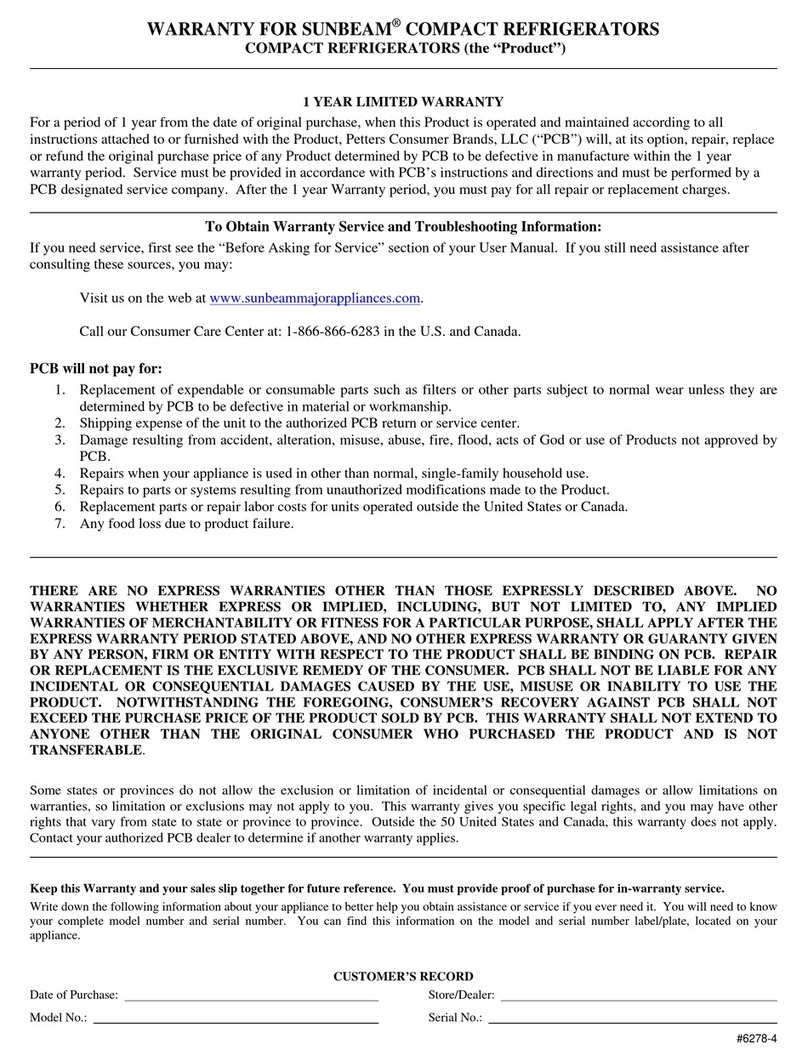
Sunbeam
Sunbeam Compact Refrigerators Parts list manual
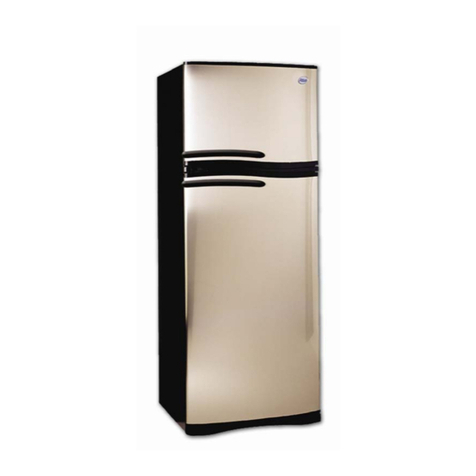
Sunbeam
Sunbeam 20060328 User manual
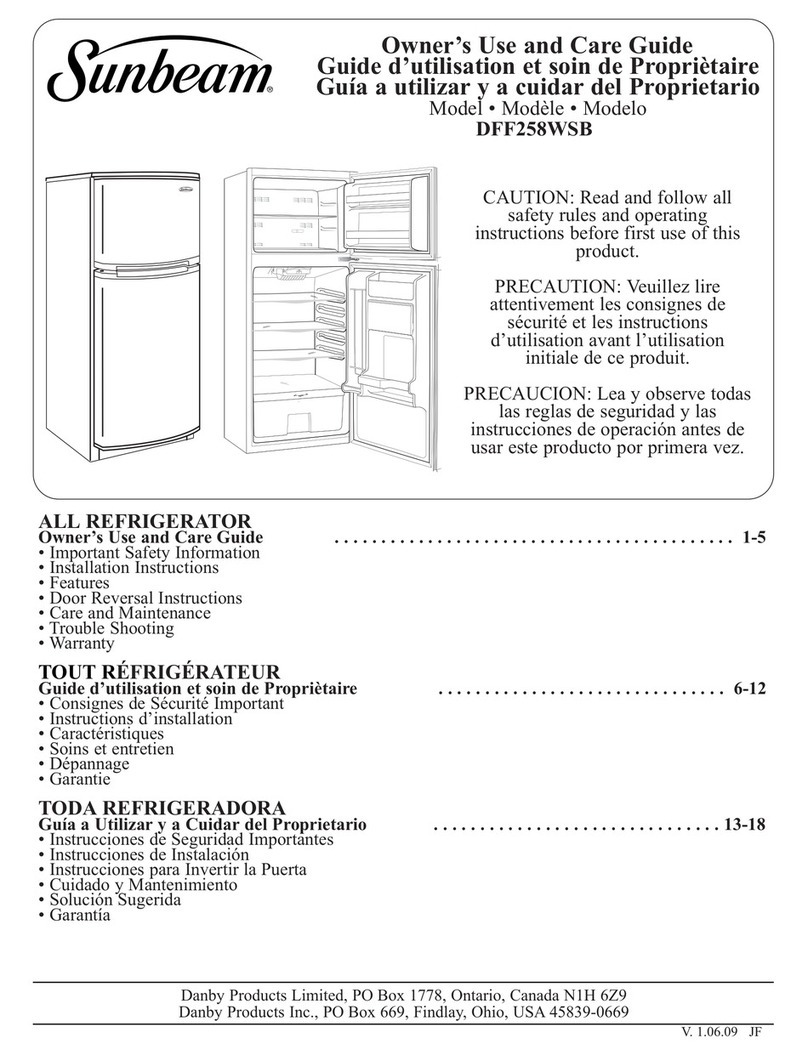
Sunbeam
Sunbeam DFF258WSB Assembly instructions
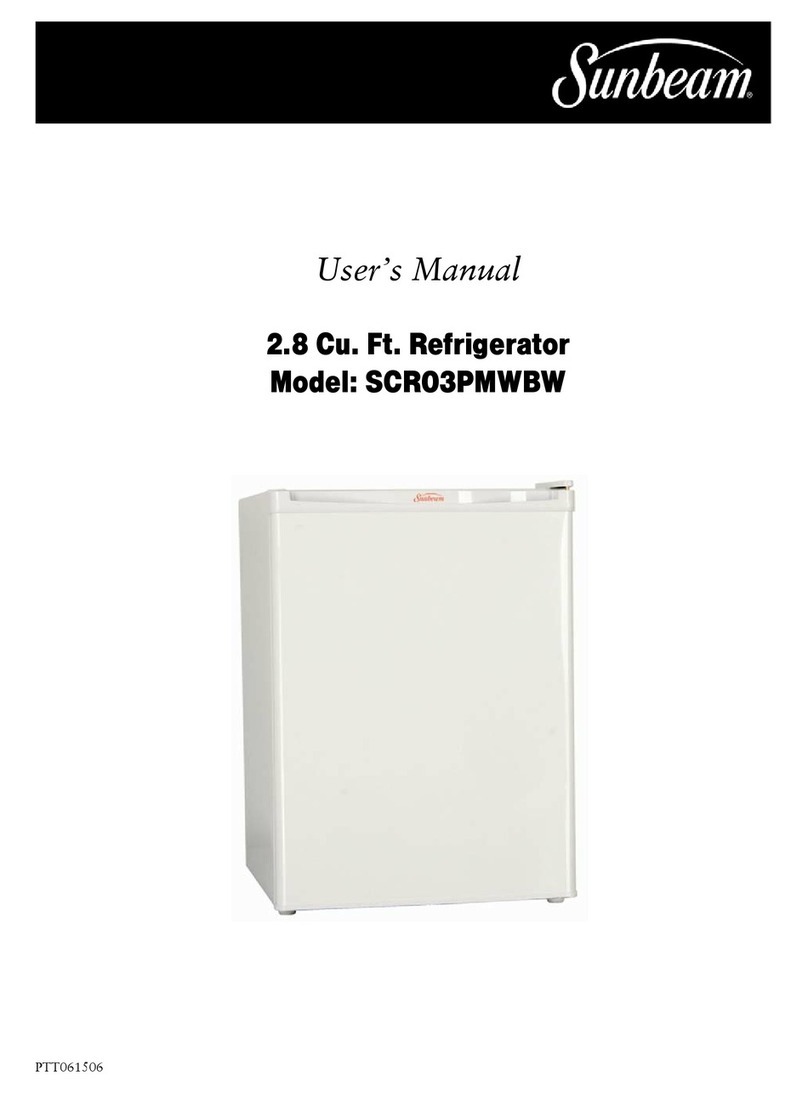
Sunbeam
Sunbeam SCR03PMWBW User manual
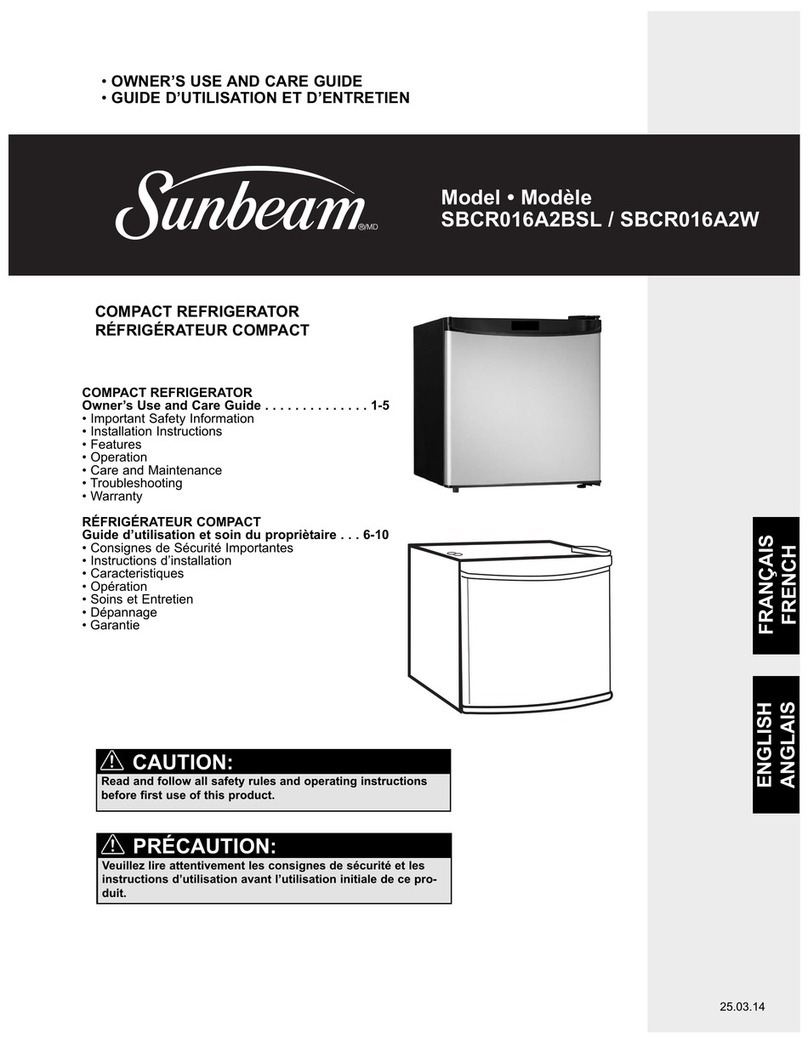
Sunbeam
Sunbeam SBCR016A2BSL Assembly instructions
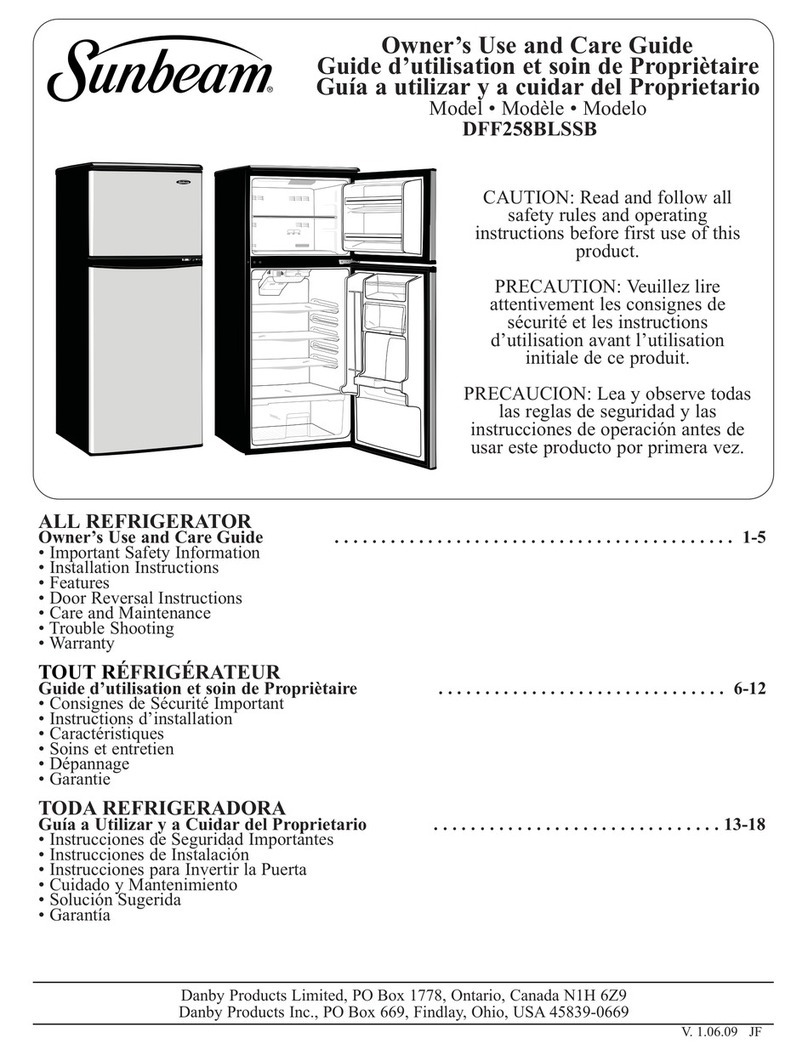
Sunbeam
Sunbeam DFF258BLSSB Assembly instructions
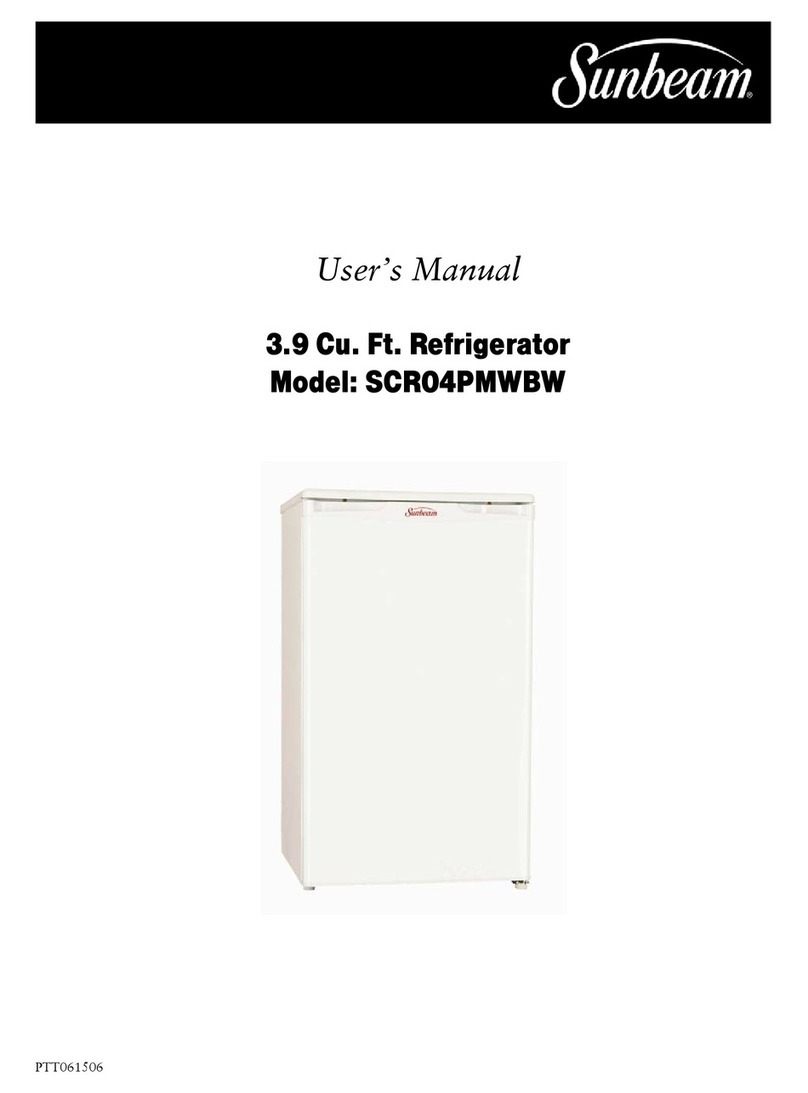
Sunbeam
Sunbeam SCR04PMWBW User manual
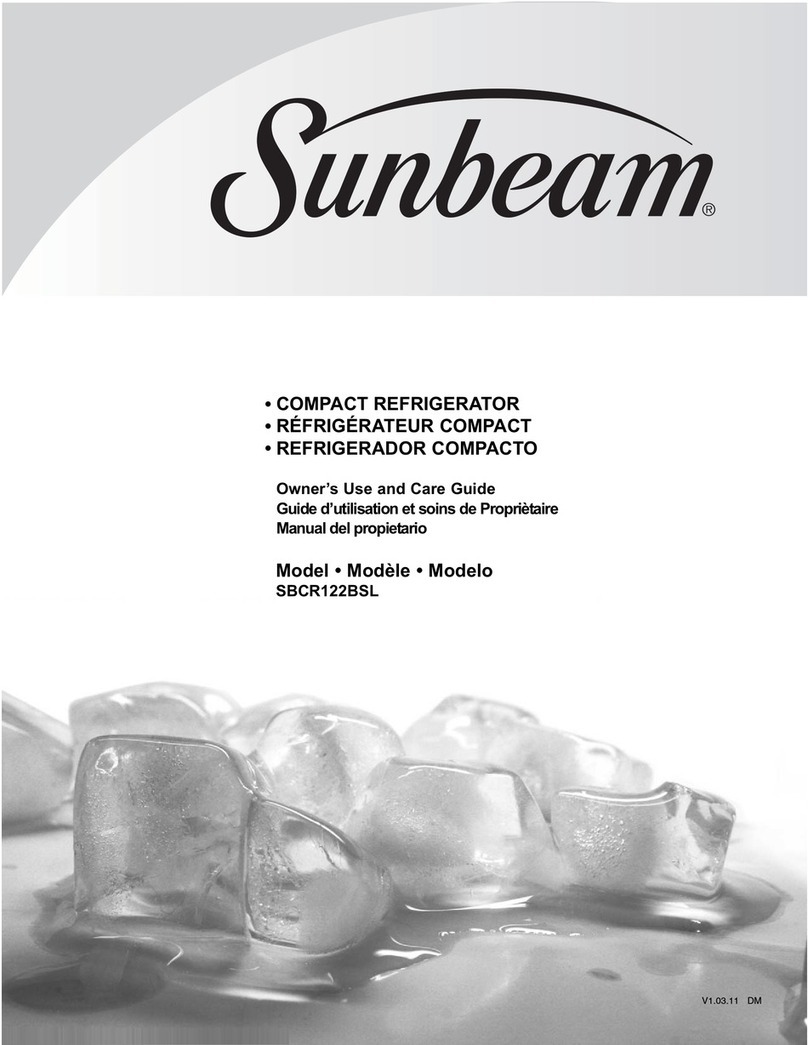
Sunbeam
Sunbeam COMPACT SBCR122BSL Assembly instructions
